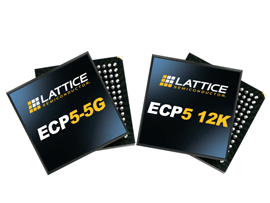Enhanced SERDES and IO Variants ExtendLeadership in Smart Connectivity Solutions
- Lattice expands its ECP5™ line of low power, small form factor FPGAs
- First to support 5G SERDES and up to 85K LUTs in a small 10×10 mm package
- Cost optimized programmable IO bridging functionality in a 12K LUT device
PORTLAND, OR –February 10, 2016–Lattice Semiconductor Corporation, the leading provider of customizable smart connectivity solutions, today announced an expansion of the company’s ECP5™family of low power, small form factor connectivity and acceleration FPGAs.These new additions are pin compatible with ECP5 FPGAs and enable OEMs to seamlessly update their designs to meet evolving interface requirements in the industrial, communications and consumer markets.
ECP5-5G
 Lattice’sECP5-5Gfamily is the only FPGA product line supporting 5G SERDES and up to 85K LUTs in a small 10×10 mm package. The ECP5-5G devices support multiple 5G protocols including PCI Express Gen 2.0, CPRI, and JESD204B.This product family enables seamless connectivity to ASICs and ASSPs in a wide array of applications including cameras, displays, gaming platforms, small cells and low-end routers. Numerous resources including software, device samples, soft IP and hardware boards are available upon request.
Lattice’sECP5-5Gfamily is the only FPGA product line supporting 5G SERDES and up to 85K LUTs in a small 10×10 mm package. The ECP5-5G devices support multiple 5G protocols including PCI Express Gen 2.0, CPRI, and JESD204B.This product family enables seamless connectivity to ASICs and ASSPs in a wide array of applications including cameras, displays, gaming platforms, small cells and low-end routers. Numerous resources including software, device samples, soft IP and hardware boards are available upon request.
ECP5 12K
The ECP5 12K deviceoffers programmable IO support for popular interface bridging functions including, LVDS, MIPI and LPDDR3.The device provides a cost optimized mix of logic, memory and DSP resources for additional pre and post processing in a variety of applications such as LED controllers, machine vision, motor control and more.Software and device samples are available upon request.
“Our ECP5 FPGA family has proven to bethe ideal solution to address the flexible connectivity needs in applications where lower power, smaller form factor and lower cost are critical requirements,” said Deepak Boppana, director of product marketing at Lattice Semiconductor. “The newECP5-5G and ECP5 12K devices will enable our customerstocontinue taking advantage of these differentiated features, while accelerating time-to-market of their next-generation designs.”






